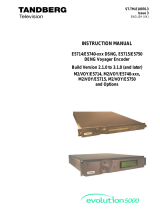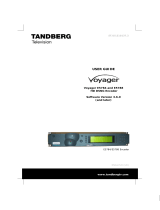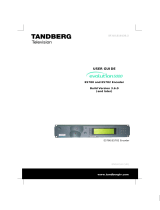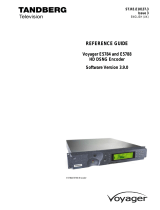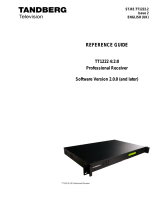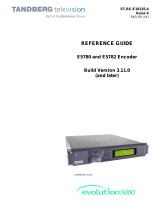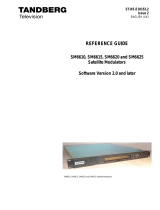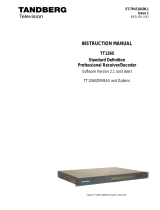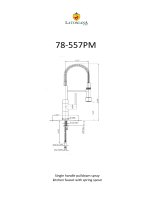Page is loading ...

ST.RE.E10076.3
Issue 3
ENGLISH (UK)
REFERENCE GUIDE
E5714/E5740-xxx DSNG,
E5750 DENG Voyager Encoder
Build Version 3.6.0 and later
1U Encoder
2U Encoder

Preliminary Pages
Page ii Reference Guide: E57xx DSNG and DENG Voyager Encoder
ST.RE.E10076.3
Issue 3 first published in 2005 by:
T
ANDBERG TELEVISION LTD
R
EGISTERED ADDRESS:
U
NIT 2 STRATEGIC PARK,
C
OMINES WAY,
H
EDGE END, SOUTHAMPTON,
H
AMPSHIRE,
SO30 4DA
Re
g
istered Com
p
an
y
Number 03695535
This document and the information contained in it is the property o
f
TANDBERG Television Ltd and may be the subject of patents
pending and granted. It must not be used for commercial purposes
nor copied, disclosed, reproduced, stored in a retrieval system o
r
transmitted in any form or by any means (electronic, mechanical,
photocopying, recording or otherwise), whether in whole or in part,
without TANDBERG Television’s prior written agreement.
2004 - 2005 TANDBERG Television Ltd. All rights reserved.
SVENSKA
LÄS DETTA FÖRST!
Om Ni inte förstår informationen i denna handbok
ARBETA DÅ INTE MED DENNA UTRUSTNING.
En översättning till detta språk av denna handbok kan också anskaffas, på
Er bekostnad.
ENGLISH (UK)
READ THIS FIRST!
If you do not understand the contents of this manual
DO NOT OPERATE THIS EQUIPMENT.
Also, translation into any EC official language of this manual can be made
available, at your cost.
ÅËËÇÍÉÊÁ
ÄÉÁÂÁÓÔÅ ÐÑÙÔÁ ÁÕÔÏ!
Áí äåí êáôáëÜâåôå ôï ðåñéå÷üìåíï áõôïý ôïõ âïçèÞìáôïò/åã÷åéñéäßïõ
ÌÇÍ ËÅÉÔÏÕÑÃÇÓÅÔÅ ÁÕÔÏÍ ÔÏÍ ÅÎÏÐËÉÓÌÏ.
Åðßóçò, áõôü ôï åã÷åéñßäéï åßíáé äéáèÝóéìï óå ìåôÜöñáóç
óå áõôÞ ôç ãëþóóá êáé ìðïñåßôå íá ôï áãïñÜóåôå.
DEUTSCH
LESEN SIE ZUERST DIESEN HINWEIS!
Sollte Ihnen der Inhalf dieses Handbuches nicht klar verständlich sein,
dann
BEDIENEN SIE DIESE GERÄTE NICHT!
Eine Übersetzung des Handbuches in diese Sprache ist gegen
Berechnung lieferbar.
ESPAÑOL
LEA ESTE AVISO PRIMERO!
Si no entiende el contenido de este manual
NO OPERE ESTE EQUIPO.
Podemos asimismo suministrarle una traducción de este manual al
(idioma) previo pago de una cantidad adicional que deberá abonar usted
mismo.
FRANÇAIS
AVANT TOUT, LISEZ CE QUI SUIT!
Si vous ne comprenez pas les instructions contenues dans ce manuel
NE FAITES PAS FONCTIONNER CET APPAREIL.
En outre, nous pouvons vous proposer, à vos frais, une version française
de ce manuel.
ITALIANO
LEGGERE QUESTO AVVISO PER PRIMO!
Se non si capisce il contenuto del presente manuale
NON UTILIZZARE L’APPARECCHIATURA.
È anche disponibile la versione italiana di questo manuale, ma il costo è a
carico dell’utente.
PORTUGUÊS
LEIA O TEXTO ABAIXO ANTES DE MAIS NADA!
Se não compreende o texto deste manual
NÃO UTILIZE O EQUIPAMENTO.
O utilizador poderá também obter uma tradução do manual para o
português à própria custa.
NEDERLANDS
LEES DIT EERST!
Als u de inhoud van deze handleiding niet begrijpt
STEL DEZE APPARATUUR DAN NIET IN WERKING.
U kunt tevens, op eigen kosten, een vertaling van deze handleiding
krijgen.
DANSK
LÆS DETTE FØRST!
Udstyret må ikke betjenes
MEDMINDRE DE TIL FULDE FORSTÅR INDHOLDET AF DENNE
HÅNDBOG.
Vi kan også for Deres regning levere en dansk oversættelse af denne
håndbog.
SUOMI
LUE ENNEN KÄYTTÖÄ!
Jos et ymmärrä käsikirjan sisältöä
ÄLÄ KÄYTÄ LAITETTA.
Käsikirja voidaan myös suomentaa asiakkaan kustannuksella.

Preliminary Pages
Reference Guide: E57xx DSNG and DENG Voyager Encoder Page iii
ST.RE.E10076.3
List of Contents
Chapter 1: Introduction to the Basic Encoder
Gives a general description of the equipment and its main features and
functions. Identifies the controls, indicators and connectors on the front
and rear panels.
Chapter 2: Installing the Equipment
Provides a guide to the suitability of an installation and gives detailed
procedures for the preparation and installation of the equipment. Also
details the external connectors and provides important safety
information.
Chapter 3: Options and Upgrades
This chapter describes the options and upgrades available for the
E57xx series of Encoder models.
Chapter 4: Operating the Equipment Locally
Describes local control in detail. Provides the power-up/power-down
procedures and other general operating/control/set-up procedures.
Chapter 5: Web Browser Interface
Details how to access and use the Web Browser Interface for a range of
diagnostic and other utilities.
Chapter 6: Preventive Maintenance and Fault-finding
Details routine maintenance tasks to be performed by the operator and
provides general servicing advice and fault-finding information. Provides
information regarding warranty and maintenance available from Customer
Services. Gives relevant disposal information.
Annex A: Glossary
Annex B: Technical Specification
Annex C: Language Abbreviations
Annex D: Creating and Downloading a Logo
Annex E: Band Plans
Annex F: Audio Modes
Annex G: Accuracy of Frequency Sources
Annex H: Use of Remux Card in ATSC
Annex I: EDH Capability for E57xx Encoders

Preliminary Pages
Page iv Reference Guide: E57xx DSNG and DENG Voyager Encoder
ST.RE.E10076.3
About this Reference Guide
This Reference Guide provides instructions and information for the
installation, operation of the Encoder.
This Reference Guide should be kept in a safe place for reference for the
life of the equipment. It is not intended that this Reference Guide will be
amended by the issue of individual pages. Any revision will be by a
complete reissue. Further copies of this Reference Guide can be ordered
from the address shown on page viii. If passing the equipment to a third
party, also pass the relevant documentation.
Issues of this Reference Guide are listed below:
Issue Date Build Version Comments
1 June 2003 3.2 Initial release.
2 June 2004 3.5 and later
3 January 2005 3.6.0
Include functionality of SV 3.6.0. Delete obsolete options. Add
new Satmod, L-band and GPI cards.
NOTE…
The Build Version in the table refers to an overall number which encompasses all the various
software/firmware versions of video, audio, etc in the Encoder.
The following documents are also associated with this equipment:
• ST.US.E10076: User Guide
• ST.TS.SNMP.E10074: Simple Network Management Protocol
• ST.TS.E10074 Remote Control Protocol
• ST.AN.1094: Video Noise Reduction and Compression
• ST.AN.1110: Near Loss-less MPEG Concatenation
Without Helper Signals
• ST.AN.BW.E10074: Variable Bandwidth Feature of E57xx
Encoders
Nomenclature
The terms RS-232 and RS-422 have been superseded by EIA-232 and
EIA-422. However, because the original names are inscribed on the
Encoder the original terms are used in the text of this Reference Guide.

Preliminary Pages
Reference Guide: E57xx DSNG and DENG Voyager Encoder Page v
ST.RE.E10076.3
Acknowledgements
General
All best endeavours have been made to acknowledge registered
trademarks and trademarks used throughout this Reference Guide. Any
notified omissions will be rectified in the next issue of this Reference
Guide. Some trademarks may be registered in some countries but not in
others.
Registered trademarks and trademarks used are acknowledged below and
marked with their respective symbols. However, they are not marked
within the text of this Reference Guide.
Registered Trademarks
AC-3
®
, Dolby Digital
®
and Pro Logic
®
are registered trademarks of Dolby
Laboratories Licensing Corporation.
Musicam
®
is a registered trademark of Thomson and Télédiffusion de
France (TDF), Europe, and is a registered trademark of CCS (now Musicam
USA Incorporated), USA.
Ethernet
®
is a registered trademark of Xerox Corporation.
XILINX
®
is a registered trademark of Xilinx Inc.
Trademarks
Pozidriv™ is a trademark of European Industrial Services.
Reflex™ is a trademark of TANDBERG Television.
Windows NT™ is a trademark of Microsoft Corporation.
STREAMS™ is a trademark of TANDBERG Television.
NDS™ is a trademark of NDS Limited.

Preliminary Pages
Page vi Reference Guide: E57xx DSNG and DENG Voyager Encoder
ST.RE.E10076.3
Warnings, Cautions and Notes
Heed Warnings
All warnings on the product and in the operating instructions should be
adhered to. The manufacturer can not be held responsible for injuries or
damage where warnings and cautions have been ignored or taken lightly.
Read Instructions
All the safety and operating instructions should be read before this product
is operated.
Follow Instructions
All operating and use instructions should be followed.
Retain Instructions
The safety and operating instructions should be retained for future
reference.
WARNINGS...
WARNINGS GIVE INFORMATION WHICH, IF STRICTLY OBSERVED, WILL PREVENT PERSONAL
INJURY OR DEATH, OR DAMAGE TO PERSONAL PROPERTY OR THE ENVIRONMENT. THEY
ARE BOXED AND SHADED FOR EMPHASIS, AS IN THIS EXAMPLE, AND ARE PLACED
IMMEDIATELY PRECEDING THE POINT AT WHICH THE READER REQUIRES THEM.
CAUTIONS...
Cautions give information which, if strictly followed, will prevent damage to equipment or other goods.
They are boxed for emphasis, as in this example, and are placed immediately preceding the point at
which the reader requires them.
NOTES...
Notes provide supplementary information. They are highlighted for emphasis, as in this example, and
are placed immediately after the relevant text.
EMC Compliance
This equipment is certified to the EMC requirements detailed in Annex B,
Technical Specification. To maintain this certification, only use the leads
supplied or if in doubt contact Customer Services.

Preliminary Pages
Reference Guide: E57xx DSNG and DENG Voyager Encoder Page vii
ST.RE.E10076.3
Contact Information
TANDBERG Television Customer Services
Support Services
Our primary objective is to provide first class customer care that is tailored
to your specific business and operational requirements. All levels are
supported by one or more service performance reviews to ensure the
perfect partnership between TANDBERG Television and your business.
Warranty
All TANDBERG Products and Systems are designed and built to the highest
standards and are covered under a comprehensive 12 month warranty.
Levels of Continuing TANDBERG Television Service Support
For stand-alone equipment, then TANDBERG Television BASIC
Advantage is the value for money choice for you. BASIC provides you
with year-by-year Service long after the warranty has expired.
For systems support you can choose either Gold or Silver Advantage.
These packages are designed to save you costs and protect your income
through enlisting the help of TANDBERG Television support specialists.
VOYAGER Advantage is the truly mobile service solution. This provides a
package specifically designed to keep you mobile and operational.
Call TANDBERG Sales for more details.
Where to Find Us
Europe, Middle East +44 (0) 23 8048 4455
and Africa: Fax: +44 (0) 23 8048 4467
Americas: +1 (321) 308 0470
China: +86 10 6856 0260 (Beijing)
+852 2530 3215 (Hong Kong)
Australia/NZ: +612 8923 0450
Internet Address: http://www.tandbergtv.com

Preliminary Pages
Page viii Reference Guide: E57xx DSNG and DENG Voyager Encoder
ST.RE.E10076.3
Technical Training
Training Courses
TANDBERG Television provides a wide range of training courses on the
operation and maintenance of our products and on their supporting
technologies. TANDBERG can provide both regularly scheduled courses and
training tailored to individual needs. Courses can be run either at your
premises or at one of our dedicated training facilities.
Where to Find Us
For further information on TANDBERG Television's training programme
please contact us:
International Telephone: +44 23 8048 4229
International Facsimile +44 23 8048 4467
E-mail Address: [email protected]
Internet Address http://www.tandbergtv.com
Customer Services and Technical Training Postal Address
Tandberg Television
Unit 2
Strategic Park
Comines Way
Hedge End
Southampton
Hampshire
SO30 4DA
United Kingdom
Return of Equipment
If you need to return equipment for repair, please contact the Customer
Services Helpdesk on +44 (0) 23 8048 4455. A Returns Authorisation
Number (RAN) will be issued and full details of the unit will be logged.
Please ensure the RAN number is clearly marked on the packaging of the
unit. The unit should then be sent to the following address:
Tandberg Television – Customer Services
Unit 1
Strategic Park
Comines Way
Hedge End
Southampton
Hampshire
SO30 4DA
United Kingdom
Technical Publications
If you need to contact TANDBERG Television Technical Publications
regarding this publication, e-mail: [email protected].

Reference Guide: E57xx DSNG and DENG Voyager Encoder Page 1-1
ST.RE.E10076.3
Chapter 1
1. Introduction to the Basic Encoder
Contents
1.1 Scope of this Reference Guide.................................1-3
1.1.1 Who Should Use This Reference Guide.......1-3
1.1.2 Build Version ................................................1-3
1.1.3 What Equipment is Covered by This
Reference Guide ..........................................1-3
Equipment Models........................................1-3
1.2 Role of the Encoder in a System...............................1-4
1.2.1 Typical System.............................................1-4
1.2.2 DSNG Systems ............................................1-5
Overview.......................................................1-5
E5714...........................................................1-6
E5740/E5760................................................1-6
1.2.3 DENG Systems ............................................1-6
1.3 Summary of Features ...............................................1-7
1.3.1 Video Encoding ............................................1-7
MPEG-2 Encoding........................................1-7
Video Encoding Modes.................................1-7
Video Inputs..................................................1-7
Video Input Types.........................................1-7
Serial Digital Video Input Error Detection
and Handling (EDH) .....................................1-7
Video Encoding Functions............................1-7
Motion Estimation.........................................1-8
Variable Video Bit-rate..................................1-8
Coding Resolutions ......................................1-8
Internal Frame Synchroniser........................1-8
Output on Video Loss...................................1-9
1.3.2 Audio Encoding ............................................1-9
General.........................................................1-9
Audio Inputs..................................................1-9
Audio Channels..........................................1-10
Output on Digital Audio Loss......................1-10
MPEG Encoding Modes..............................1-10
Dolby Digital (AC-3) Encoding Modes.........1-10
Test Tones..................................................1-10
Audio Variable Bit-rate................................1-10
Dolby Digital (AC-3)....................................1-11
1.3.3 Vertical Blanking Interval (VBI) Line
Processing Modes.......................................1-11
Introduction.................................................1-11
VBI in Picture..............................................1-11
VBI User Data.............................................1-11
VBI in PID ...................................................1-11
Teletext Extraction......................................1-12
1.3.4 Data Channels............................................1-12
1.3.5 Outputs .......................................................1-12
1.3.6 IF Modulation..............................................1-13
E5714..........................................................1-13
E5740..........................................................1-13
E5750..........................................................1-13
1.3.7 Control and Monitoring................................1-13
1.3.8 Options and Upgrades................................1-13
1.4 Guided Tour ............................................................1-14
1.4.1 Enclosure....................................................1-14
1.4.2 Front Panel Description ..............................1-14
Front Panel Display, Navigation Keys,
Softkeys, Keyboard.....................................1-14
Power Supply Stand-by Switch...................1-14
1.4.3 Rear Panel Description...............................1-15
Introduction.................................................1-15
1.4.4 Boards in the Basic Encoder.......................1-16

Introduction to the Basic Encoder
Page 1-2 Reference Guide: E57xx DSNG and DENG Voyager Encoder
ST.RE.E10076.3
List of Figures
Figure 1.1: 1U Encoder Front View............................................... 1-4
Figure 1.2: 2U Encoder Front View............................................... 1-4
Figure 1.3: Typical DSNG Encoder Configuration......................... 1-5
Figure 1.4: Typical DENG System Configuration..........................1-6
Figure 1.5: 1U Encoder Front Panel Indicators........................... 1-14
Figure 1.6: Stand-by Switch ........................................................1-15
Figure 1.7: 2U Encoder Front Panel Indicators........................... 1-15
Figure 1.8: E5750 (2U) Rear Panel Component Parts and
Connectors................................................................. 1-15
List of Tables
Table 1.1: Build Version ................................................................1-3
Table 1.2: Equipment Model Descriptions..................................... 1-4
Table 1.3: Video Bit-rate Range ................................................... 1-8
Table 1.4: Front Panel Indicators ................................................1-14
Table 1.5: Boards in the Basic Encoder...................................... 1-16

Introduction to the Basic Encoder
Reference Guide: E57xx DSNG and DENG Voyager Encoder Page 1-3
ST.RE.E10076.3
1.1 Scope of this Reference Guide
1.1.1 Who Should Use This Reference Guide
This Reference Guide is written for operators/users of the 1U and 2U
Voyager Encoders to assist in the installation, operation and day-to-day
care. These Encoders are referred to throughout this Reference Guide as
‘Encoder(s)’ unless there is a specific difference, where they will be
referred to by the model number.
WARNING…
DO NOT REMOVE THE COVERS OF THIS EQUIPMENT. HAZARDOUS VOLTAGES ARE PRESENT
WITHIN THIS EQUIPMENT AND MAY BE EXPOSED IF THE COVERS ARE REMOVED. ONLY
TANDBERG TELEVISION TRAINED AND APPROVED SERVICE ENGINEERS ARE PERMITTED TO
SERVICE THIS EQUIPMENT.
CAUTION…
Unauthorised maintenance or the use of non-approved replacements may affect the equipment
specification and invalidate any warranties.
This Reference Guide does not include any maintenance information or
procedures which would require the removal of covers.
1.1.2 Build Version
This Reference Guide has been written to cover the functionality in
Table 1.1.
Table 1.1: Build Version
E5714, E5740, E5750
Build Version 3.6.0 and later
The Build version indicates the status of the Encoder and refers to an
overall number which encompasses all the various software/firmware
versions of video, audio, etc. in the Base Board.
The current Build version can be found in the Build Menu (see Chapter 4,
Operating the Equipment Locally, Figure 4.9).
This number should be
quoted in all correspondence with TANDBERG Television.
1.1.3 What Equipment is Covered by This Reference Guide
Equipment Models
Each model of Encoder comprises an enclosure with a Base Board and
Modulator fitted as standard. The E5714 and E5740 are fitted with a
Satellite Modulator; the E5750 is fitted with an OFDM Modulator.
There are vacant slots for option modules; one in the E5714; three in the
E5760; four in the E5740; five in the E5750. These slots can be occupied
by any combinations of modules shown in Chapter 3, Options and
Upgrades.

Introduction to the Basic Encoder
Page 1-4 Reference Guide: E57xx DSNG and DENG Voyager Encoder
ST.RE.E10076.3
Figure 1.1: 1U Encoder Front View
Figure 1.2: 2U Encoder Front View
Table 1.2: Equipment Model Descriptions
Model
Number
Marketing
Code
Description
E5714 Encoder M2/VOY/E5714 1U MPEG-2 DSNG Encoder with QPSK modulator. Has
4:2:0/4:2:2
1
video encoding mode and fully exhaustive motion
estimation.
E5740 Encoder M2/VOY/E5740 2U MPEG-2 DSNG Encoder with IF output satellite
modulator. Has 4:2:0/4:2:2
1
video encoding mode and fully
exhaustive motion estimation.
E5740 Encoder M2/VOY/E5740-
LBAND
2U MPEG-2 DSNG Encoder with L-band output Satellite
Modulator. Has 4:2:0/4:2:2
1
video encoding mode and fully
exhaustive motion estimation.
E5750 Encoder M2/VOY/E5750 2U MPEG-2 DENG Encoder with OFDM modulator. Has
4:2:0/4:2:2
1
video encoding mode and fully exhaustive motion
estimation.
1.2 Role of the Encoder in a System
1.2.1 Typical System
The Encoder is a transportable digital exciter designed specifically for
mobile contribution applications. It is compact and lightweight, fully
MPEG-2 and DVB or ATSC compliant and has high performance for the
transmission of studio-quality video material. The equipment is designed to
be suitable for both flyaway use (within an appropriate flight case) and
truck installation.
The E5714 and E5740 contain the same high performance Encoder. The
E5714 is a 1U chassis housing the Encoder and a QPSK Satellite Modulator.
The E5740 is a 2U chassis housing the Encoder, and a Satellite Modulator
capable of QPSK, 8PSK
2
and 16QAM
3
modulation.
1
4:2:2 is only available when software option M2/ESO2/422 is purchased.
2
8PSK is only available when software option M2/ESO2/SM38PSK is purchased.
3
16QAM is only available when software option M2/ESO2/SM316QAM is purchased.

Introduction to the Basic Encoder
Reference Guide: E57xx DSNG and DENG Voyager Encoder Page 1-5
ST.RE.E10076.3
The Encoder has one card, containing a single video encoder, two stereo
audio encoders (dual standard MPEG-1 (layer 2)/Dolby Digital (AC-3)
4
),
composite video decoder, CA
5
, data input and general purpose VBI
extraction and encoding circuitry. It also contains either a satellite
modulator or an OFDM modulator.
High quality 4:2:0 or 4:2:2
6
video encoding is ensured by the inclusion of
digital noise reduction techniques
7
and many other proprietary algorithms
as well as standard MPEG compression techniques. Fully Exhaustive motion
estimation is also used.
Video can be input to the unit in serial digital component (SDI) format or
composite analogue (PAL/NTSC). There is also a logo overlay facility
allowing broadcasters to trademark material.
The audio functionality supports multiple sampling frequencies, bit-rates
and coding modes. Audio can be input in balanced analogue, digital
AES/EBU input as a discrete channel or embedded on serial digital video.
Various coding standards are supported, including Linear PCM. Additional
audio channels can be accommodated by purchasing the option module
M2/EOM2/AUDLIN2.
Unit functionality can be further extended with option modules (see
Chapter 3, Options and Upgrades).
1.2.2 DSNG Systems
Overview
Figure 1.3: Typical DSNG Encoder Configuration
4
Dolby Digital (AC-3) is only available when software option M2/ESO2/AC3 is purchased.
5
CA relates to RAS and BISS. RAS and BISS are only available when software options M2/ESO2/RAS and
M2/EDCOM2/BISS are purchased. A E57xx Encoder may be fitted with both RAS and BISS options but only one
scrambling format can be used at any one time. BISS is available from Build version 2.1.0 but BISS- is not supported
before Build version 2.2.0.
6
4:2:2 is only available when software option M2/ESO2/422 is purchased.
7
Noise reduction is only available when software option M2/ESO2/NR is purchased.
Tx
Rx
Up-link equipment
(including Up-converte
r
and High Power Amplifier)
Down-link equipment
(including Low Noise Block
and Down-converter)
IF
VIDEO
AUDIO
ASYNC DATA
SYNC DATA
Encoder
Modulator
VIDEO (ANALOGUE)
VIDEO (DIGITAL)
AUDIO
SYNC DATA
ASYNC DATA
DSNG Encoder
ALARM
REMOTE CNTRL
AUTHORIZED
LOCK
STATUS
BER STATUS
MULTIFUNCTIONAL DISPLA
Y
ALTEI
A
Satellite Receiver

Introduction to the Basic Encoder
Page 1-6 Reference Guide: E57xx DSNG and DENG Voyager Encoder
ST.RE.E10076.3
E5714
The satellite modulator within the E5714 supports QPSK modulation in
accordance with EN 300 421 (DVB-S). It provides a main and monitoring
IF Output. The IF frequency can be tuned between 50 MHz and 90 MHz, or
950 – 1750 MHz on the E5714 L-band.
E5740/E5760
The satellite modulator fitted within the E5740 is capable of QPSK
modulation in accordance with EN 300 421 (DVB-S), and is also capable of
8PSK and 16QAM modulation in accordance with EN 301 210 (DVB-DSNG).
It is available in two variants. One provides an IF output tuneable in the
range 50 MHz to 180 MHz. The other provides an L-band output tuneable
in the range 950 MHz to 1750 MHz.
1.2.3 DENG Systems
E5715/E5750
Encoder
Radio Tx Radio Rx
Rec / Mon
Equipment
70 MHz IF
Figure 1.4: Typical DENG System Configuration
The OFDM modulator fitted in the E5750 takes the Encoder’s output
transport stream, and uses Coded Orthogonal Frequency Division
Multiplexing (COFDM) to spread the data over 1705 carriers (2k mode) or
6817 carriers (8k mode). This means that relatively low data rates can be
used on each carrier frequency, and any multipath effects (ghosting) which
occur affects only a small amount of data.
The carriers are closely spaced so that their sidebands overlap, but due to
the orthogonal relationship between carrier frequencies they do not
interfere with each other. This makes the system spectrally efficient.
Noise, multipath effects, co-channel interference and other impairments
can cause some bits to be received in error. Therefore, Forward Error
Correction (FEC) consisting of Reed-Solomon (RS) coding followed by
convolution coding is used to add extra bits to the transmitted signal. This
allows a large number of errors at the receive end to be corrected by
convolutional (Viterbi) decoding followed by RS decoding.
Five convolutional rates are available: ½,
2
/
3
, ¾,
5
/
6
and
7
/
8
. These provide
different compromises between bit-rate and ruggedness.
The modulation scheme used on each carrier can either be QPSK, 16QAM,
or 64QAM. These also provide different compromises between bit-rate and
ruggedness, QPSK being the most rugged.
Four guard intervals are available
1
/
32
,
1
/
16
,
1
/
8
, and ¼. These are used to
reduce the effects of intersymbol interference at the receive end caused by
multipath propagation.
The output of the modulator is 70 MHz IF for connection to a suitable radio
transmitter.

Introduction to the Basic Encoder
Reference Guide: E57xx DSNG and DENG Voyager Encoder Page 1-7
ST.RE.E10076.3
1.3 Summary of Features
1.3.1 Video Encoding
MPEG-2 Encoding
The Encoder processes a broadcast-standard video signal into a
compressed encoded bit-stream in accordance with:
• The MPEG-2 Main profile @ Main level (MP@ML) specification
(ISO/IEC 13818)
• The MPEG-2 4:2:2
8
profile @ Main Level (422P@ML) specification
(ISO/IEC 13818)
Video Encoding Modes
Either the 4:2:0 or 4:2:2
8
video encoding modes can be selected. The
coding mode selected affects the compression techniques, encoder delay
and rate control.
Video Inputs
The standard video inputs are:
• SDI - Serial Digital Interface - ITU-R BT.656-4, part 3 (D1 serial
format) – SMPTE 259 (component only)
• Composite Analogue (PAL/NTSC)
Video Input Types
The video input types which are supported are:
• 625-line composite PAL-B, -D, -G, -H or -I (ITU-R BT. 624-4)
• 525-line composite NTSC-M (with and without pedestal) or PAL-M
(ITU-R BT. 624-4)
• Serial digital (ITU-R BT.656-4, part 3) input (D1 serial format) and
(ANSI/SMPTE 259M) (component only)
• Internal test pattern function
Serial Digital Video Input Error Detection and Handling (EDH)
The serial digital video input supports error detection and handling (EDH)
9
as defined by the specification SMPTE RP 165-1994, ‘Error Detection
Checkwords and Status Flags for Use in Bit Serial Digital Interfaces for
Television’.
Video Encoding Functions
The standard video encoding functions include:
• Support for all MP@ML and 422P@ML
8
standard coding modes
• Selectable bit-rate operation, <1.5 Mbit/s - 50 Mbit/s (see Table 1.3)
10
• Support for the standard set of video picture resolutions (720, 704,
640, 544, 480, 352) in both 625 and 525 line operation. 352 supports
full and half-vertical resolution in both 625 and 525 line operation
8
4:2:2 is only available when software option M2/ESO2/422 is purchased.
9
Error detection and handling is not currently supported.
10
Bit-rates lower than 1.5 Mbit/s are only available when the software option M2/ESO2/PU is purchased.

Introduction to the Basic Encoder
Page 1-8 Reference Guide: E57xx DSNG and DENG Voyager Encoder
ST.RE.E10076.3
• Fully exhaustive motion estimation
• An internal frame synchroniser (see Internal Frame Synchroniser on
Page 1-8)
• Support for Active Format Descriptor (AFD) (see Chapter 4, Operating
the Equipment Locally, Table 4.36)
• Support for a variety of Group of Pictures (GOP) structures with a
variable number of B frames
• Built-in patented adaptive noise reduction circuitry
11
• A logo overlay facility whereby the Encoder is able to overlay
broadcasters trademarks/logos onto the active video
Motion Estimation
Fully Exhaustive motion estimation is used. It takes a macro block of
16 pixels x 16 pixels and then performs an exhaustive search without
subsampling.
Variable Video Bit-rate
The MPEG-2 compression algorithm uses adaptive field/frame coding,
forward and backward predictive processing with motion estimation and
compensation to reduce the bit-rate to the range shown in Table 1.3.
Table 1.3: Video Bit-rate Range
12
Video Encoding Mode
4:2:0 4:2:2
13
1.5 Mbit/s - 15 Mbit/s 1.5 Mbit/s - 50 Mbit/s
NOTE…
Minimum bit-rate is 0.25 Mbit/s when software option M2/ESO2/PU is purchased.
Coding Resolutions
To provide optimum picture quality over the full range of supported
bit-rates, the encoded picture resolution is controlled automatically
according to the video bit-rate. Alternatively, the user can override this
and select manual control, if desired. Coding resolutions are shown in
Annex B, Technical Specification.
Internal Frame Synchroniser
An internal frame synchroniser is provided to accommodate slight
differences between the incoming frame rate and that generated by the
stable reference
14
used by the Encoder.
11
Noise reduction is only available when software option M2/ESO2/NR is purchased.
12
The video bit-rate depends on the Multiplexer bit-rate which is set.
13
4:2:2 is only available when software option M2/ESO2/422 is purchased.
14
To ensure broadcast quality it is recommended that the studio reference is fed to HYSNC.

Introduction to the Basic Encoder
Reference Guide: E57xx DSNG and DENG Voyager Encoder Page 1-9
ST.RE.E10076.3
Output on Video Loss
The Encoder can be software-configured to show, in the event of video
input loss, either:
• A test pattern (with or without ident text)
• A freeze frame (with or without ident text)
• Cut to a black screen (with or without ident text)
• Drop the video PID
• Turn off the ASI output of the Encoder
1.3.2 Audio Encoding
General
Audio can be encoded to:
• MPEG-1 Audio (layer 2) standard (sampling rate 32 kHz or 48 kHz).
• Dolby Digital (AC-3)
15
(sampling rate 32 kHz or 48 kHz)
16
.
Output bit-rate is selectable in the range 32 kbit/s - 384 kbit/s
(dependent on configuration) for MPEG-1 Audio (layer 2) and
56 kbit/s - 640 kbit/s (dependent on configuration) for Dolby Digital
(AC-3) coding mode selectable between 1/0 and 2/0.
• Dolby Digital (AC-3) pre-encoded audio (IEC 61937 specification) in
pass-through mode is also available (it only operates at 48 kHz). This
is where an audio stream has already been encoded externally, prior to
entering the Encoder.
• Linear PCM
16
(SMPTE 302M).
• Dolby E Pass-thru
16
• DTS Pass-thru
16
.
NOTES…
1. See Annex F, Audio Modes for details of setting up the audio.
2. MPEG-1 audio sampling rate is fixed at 48 kHz when controlled from the front panel.
Audio Inputs
The standard audio input is:
• AUDIO IN – 15-way male D-type - software selectable balanced
analogue or digital AES/EBU, with AES/EBU on left only. A break-out
cable is supplied which plugs into this connector and provides a more
convenient means of connecting the audio inputs via five connectors.
There are four XLR female connectors, with the fifth cable being a BNC
which provides an AES/EBU 75 Ω digital reference output.
• Alternatively, audio can be input embedded as AES/EBU on the serial
digital interface (SDI). In this mode a maximum of four stereo pairs
can be extracted from any two Data Identifiers (DIDs). Audio may be
converted to either of the standard output sampling frequencies,
32 kHz or 48 kHz, by use of the built-in asynchronous sample rate
converters. This applies only to audio which is not pre-encoded.
15
Dolby Digital (AC-3) is only available when software option M2/ESO2/AC3 is purchased.
16
To achieve lip sync in all modes the audio option M2/EOM2/AUDLIN2 must be used.

Introduction to the Basic Encoder
Page 1-10 Reference Guide: E57xx DSNG and DENG Voyager Encoder
ST.RE.E10076.3
Audio Channels
The Encoder Base Board is capable of processing two stereo pairs, from
any of the following
17
:
• SDI Embedded source
• Digital source AES/EBU
• Analogue source, termination impedance 600 Ω or 20 kΩ
These signals may be processed using the encoding modes in the following
section.
Output on Digital Audio Loss
The Encoder can be software-configured, in the event of loss of digital
audio input lock loss, to either:
• Code an audio stream of silence
• Drop the audio PID
• Turn off the ASI output of the Encoder
MPEG Encoding Modes
The two stereo pairs may be configured in various encoding modes:
• Single mono: either the left or the right channel is encoded - the
signal is output to both XLR connectors at the receiving end. Not
available in Linear PCM.
• Dual mono: the left and right signals are encoded and carried in the
transport stream as a single Packetised Elementary Stream (PES) data
stream. The way that the left and right signals are output from the
Receiver is dependent on how the routing is set up on the Receiver.
Both the left and the right may be output, or the left only, or the right
only. This is typically used for multilingual services. Available in
MPEG-1 (layer 2) and Linear PCM.
• Stereo: A stereo pair is coded as two mono signals - the two signals
are output as stereo at the receiving end.
• Joint stereo: A stereo pair is coded taking advantage of the stereo
nature of the channels - the two signals are output as stereo at the
receiving end. Available in MPEG-1 (layer 2) only.
• Audio Description Service
Dolby Digital (AC-3) Encoding Modes
• 1/0: centre
• 2/0: left and right
Test Tones
The equipment can be configured to generate a test tone for alignment
purposes. Refer to Annex B, Technical Specification for level and
frequency.
Audio Variable Bit-rate
MPEG-1 audio output bit-rate (see Annex B, Technical Specification) is
selectable in the range 32 kbit/s -384 kbit/s (dependent on configuration).
17
See Annex F, Audio Modes for details of setting up the audio.

Introduction to the Basic Encoder
Reference Guide: E57xx DSNG and DENG Voyager Encoder Page 1-11
ST.RE.E10076.3
Dolby Digital (AC-3)
Dolby Digital (AC-3) audio encoding incorporates digital normalisation,
preprocessing (filtering), dynamic range compression and the addition of
bit-stream information.
Dolby Pro Logic audio can be carried as stereo audio through the Encoder
as long as a suitably high bit-rate is selected (see Annex B, Technical
Specification).
1.3.3 Vertical Blanking Interval (VBI) Line Processing
Modes
Introduction
The Encoder has three modes for processing VBI lines.
NOTE…
A maximum of eight VBI lines per field may be extracted. This limit does not apply to Teletext.
VBI in Picture
By selecting the VBI in Picture extended active picture format available in
the MPEG 4:2:2 specification the Encoder compresses and transmits the
VBI data as part of the active picture. This mode requires up to 3 Mbit/s of
extra bit-rate, depending on the amount and complexity of the VBI
present.
NOTES…
1. VBI in Picture transmits the VBI waveform as part of the picture and as such will be subject to
some distortion. Most analogue VBI types are robust against this type of distortion but others,
e.g. video index, are intended for SDI transmission and will not survive MPEG coding/decoding
in VBI in Picture mode. VITS test signal and ghost cancellation signal will become corrupted.
2. VBI in Picture is not supported when 3:2 Pulldown is active.
VBI User Data
Closed Caption data, together with other formats such as VITC and AFD,
can be transmitted in the user data field of the video or relevant part of
the video stream.
VBI in PID
The Encoder has the ability to extract and transmit a wide variety of VBI
line formats. Circuitry on the front end of the equipment incorporates a
number of general purpose line grabbers so that known formats of VBI
data can be extracted.
The following VBI data formats are supported:
• Line 21 (field 1 and field 2) data Services EIA-608 (Closed Caption and
V-chip)
• Neilson AMOL 1, Neilson AMOL 11

Introduction to the Basic Encoder
Page 1-12 Reference Guide: E57xx DSNG and DENG Voyager Encoder
ST.RE.E10076.3
• VITC
18
(EBU and SMPTE)
VITC extraction from line 16 or 22 for 625-line systems (EBU
definitions), or line 14 for 525-line systems is supported.
• Programme Delivery Control (PDC), via ITU-R System B Teletext
extension data packets of type 8/30, format 2 and Line 16 Video
Programme System (VPS). Video Programming Teletext (VPT) and VPS
are trade names
• Wide Screen Signalling (WSS) (line 23) ETS 300 294
• Gemstar2x
• EIA516 (NABTS)
• Video Index (for Pan Scan, Aspect Ratio and Active Format Descriptor)
• The supported VBI line number range is 10-22 and 272-285 for 525
lines and 6-22 and 318-334 for 625 lines
Teletext Extraction
The Encoder supports internal Teletext data extraction (Teletext drop)
from the VBI of a video input and formats this data into a transport packet,
as specified in the DVB specification EN300-472. The Encoder can extract
up to 18 lines of Teletext from each field of the video frame.
Line filters can be invoked to selectively disable any individual lines in this
range. The filters are provided to allow the user to ensure that
non-Teletext lines (e.g. ITS lines) are not erroneously extracted. The
extracted Teletext lines are formatted into PES packets according to the
DVB specification. The Teletext PES packets are time-stamped to allow
correct alignment of subtitling captions with decoded video.
The following Teletext services are extractable:
• Sytem B (WST) Teletext
• Video Programming Teletext (VPT), PDC (Packet 8/30 format 2)
• Inverted Teletext
• EIA516 (NABTS)
1.3.4 Data Channels
The basic Encoder supports two data channels, an asynchronous RS-232
and a synchronous RS-442. These are provided as data pipes only, they
are not time-stamped.
1.3.5 Outputs
Three ASI-C (copper) outputs supplying a DVB and ATSC
19
MPEG-2
transport stream are supplied as standard.
18
VITC: Only timecode is extracted.
19
ATSC internal PSIP generation is not supported in Build versions 2.1.0 and 2.2.0.
/
